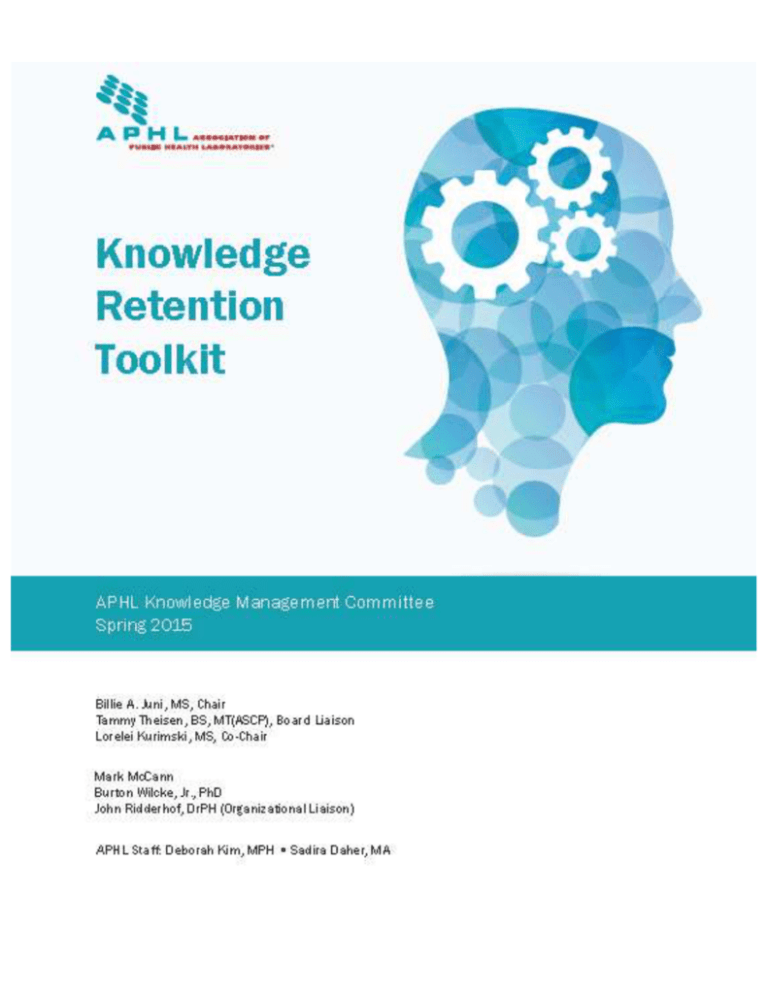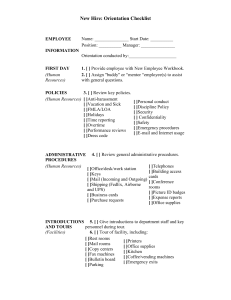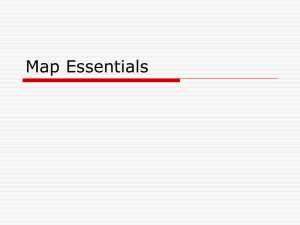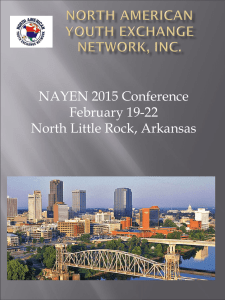Knowledge Retention Toolkit 2015- Word version
advertisement

KNOWLEDGE RETENTION TOOLKIT The tools included in the Knowledge Retention Toolkit are designed to capture and retain explicit and tacit knowledge about an individual’s position due to termination or an unexpected absence. The intent is to provide a single toolkit that your organization can implement to collect knowledge during the lifecycle of an employee. Completion of the Managing Knowledge section provides many of the components for building the Onboarding Plan for a particular job position. The Knowledge Retention Toolkit includes the following three components: • Managing Knowledge • Exit Interview • Onboarding Plan MANAGING KNOWLEDGE Explicit knowledge, formal and often codified, comes in the form of books and documents, procedures and, policy manuals. Tacit knowledge, in contrast, can be found through interactions with employees, customers and the memories of past vendors. This knowledge is hard to catalog, highly experiential, difficult to document in detail, ephemeral and transitory. It is also the basis for judgment and informed action. The Managing Knowledge section provides multiple avenues to capture at-risk and critical knowledge that is specific to performance and decision-making. It is recommended that the section be administered under the following conditions: Departing/terminating staff; Key personnel, such as managers, supervisors and program directors, whose unpredicted absence could cause a significant impact in operations; and Staff who will be on an extended absence, such as under FMLA Staff should complete the worksheets as soon it is known that they will be departing the organization and if possible, before beginning any extended absence. Key personnel should consider updating the KM worksheets annually to reflect the current state. A follow-up interview(s) should be scheduled with the staff member by the supervisor and/or peers to review and discuss responses once the worksheets are completed. The knowledge obtained can be used to assure continuation of critical activities or as guidance for building the Onboarding Plan for the new replacement. General Questions- To Be Completed by All Staff 1. What are the FIVE most important lessons you’ve learned while in your present position? Many times we find ways, commonly called “tricks of the trade” to facilitate our work and make us more accurate and efficient. Tell us about any “tricks” you know of, or lessons you’ve learned while in your position. (ex. workload organizing techniques, use of preprinted or online shortcut tools, quick-guides, etc.) 2. What procedures do you find most useful for performing your job tasks? 3. If you had just one day to brief the person who would be replacing you in your present position, what would be the FIVE most important items to pass on to that person? 4. When you need information related to your job, which specific resources do you use? Books Journals Websites Listservs E-subscriptions Co-workers, Supervisor Other- please specify 5. Tell us where you keep or store the following items. Your electronic files, for example, might be on a network drive or your PC’s hard drive. Your area’s ELECTRONIC files & data Your own work-related ELECTRONIC files & data Hardcopies, paper files & data Other documents or resources not listed above 6. Have you created any database or have other electronic tools that helped you perform your job more efficiently? Yes- Please describe: No 7. Are there any other daily operations activities for which you are responsible, but were not covered above? This could include regular reports you generate or review. Provide a description, and in case of your absence, identify someone internally that can serve as your back-up. 8. Who are the people within your organization with whom it’s most important for someone in your position to successfully interact? Please provide their name(s) and details about your interactions. Interactions include bi-directional as well as where you may serve as a subject matter expert. [Fields below to be filled in, not multiple choice] Person’s Last Name Person’s First Name Title Reasons for Interaction 9. Who are the most important people outside of your organization with whom it’s important for someone in your position to successfully interact? (These might be people at the local or state level, HazMat, major hospitals or clinics, academic institutions, etc.) Include key interactions associated with grants, cooperative agreements and contracts. Tell us the subject area, each person’s name and organization, the method and frequency of your interactions (email, telephone, in person daily, weekly, etc.) and the most common reasons for your interaction (information, mentoring, projects, etc.) Local Level/Community Partners Person’s Last Name: Person’s First Name: Title: Organization Name: Phone: Email Address: Reasons for Interaction: State- state agencies, Universities, Associations Person’s Last Name: Person’s First Name: Title: Organization Name: Phone: Email Address: Reasons for Interaction: Regional Person’s Last Name: Person’s First Name: Title: Organization Name: Phone: Email Address: Reasons for Interaction: National- Federal Agencies, Associations Person’s Last Name: Person’s First Name: Title: Organization Name: Phone: Email Address: Reasons for Interaction: 10. Are you currently working on any projects or other activities? Perhaps a research, assessment or evaluation project or a training initiative is on your calendar or maybe you are validating a testing method or gathering facts for new instrumentation or software for your area. Tell us about the project or activity(ies), any critical timeline issues and who else INTERNALLY knows or has details about these. Include pending activities that need to continue. Internal Research, Assessment or Evaluation Name of Committee, Workgroup or Project: Your Role: Description: Frequency of Meetings: Provide any Critical Timeline Issues: Contact Person’s Last Name: Contact Person’s First Name: Training, Outreach Name of Committee, Workgroup or Project: Your Role: Description: Other Name of Committee, Workgroup or Project: Your Role: Description: Frequency of Meetings: Provide any Critical Timeline Issues: Contact Person’s Last Name: Contact Person’s First Name : External Research, Assessment or Evaluation: Name of Committee, Workgroup or Project: Your Role: Organization Name: Description: Frequency of Meetings: Provide any Critical Timeline Issues: Contact Person’s Last Name: Contact Person’s First Name: Training, Outreach Name of Committee, Workgroup or Project: Your Role: Organization Name: Description: Frequency of Meetings: Provide any Critical Timeline Issues: Contact Person’s Last Name: Contact Person’s First Name: Other Name of Committee, Workgroup or Project: Your Role: Organization Name: Description: Frequency of Meetings: Provide any Critical Timeline Issues: Contact Person’s Last Name: Contact Person’s First Name: 11. Is there any other information about your work/position that you feel is important to capture for the purpose of on boarding a successor or maintaining organizational knowledge? Laboratory Director- Specific Questions: 1. What do you consider to be the most useful practices for ensuring smooth operation of the laboratory? 2. Do you have any advice or insights on finding and keeping good employees? 3. Are there any quality assurance practices you have found particularly useful? 4. What do you consider to be the best practices for providing quality testing systems? 5. How have you established and maintained lines of communication with internal and external customers in order to ensure a timely response to new laboratory service trends and program planning? 6. What do you consider best practices for strategic planning? 7. What do you consider best practices for improvements to your public health laboratory system, including outcomes from any L-SIP assessments or other quality improvement initiatives? 8. What do you consider best practices for policy development? 9. What are the key funding and contacts for the Laboratory? Laboratory Manager- Specific Questions: 1. What do you consider to be best practices in establishing quality standards? 2. What procedures and records do you have for maintaining supplies and equipment? 3. How did you ensure staff compliance? 4. What training did you or your staff need during your time at the laboratory? 5. How did you maintain the laboratory information system? (i.e. identifying information needs and problems; recommending improvements; establishing priorities; testing; writing user manuals; training employees; maintaining security and confidentiality.) 6. What new programs, tests, methods, instrumentation and procedures did you implement? Why? Do you have any recommendations in this area? 7. Do you have any tips or best practices for day-to-day operations? (i.e. cross-training, sample and testing workflow, maintaining competencies, etc.) 8. What are the key funding and contacts for your programs and what were your specific responsibilities? Laboratory Scientist- Specific Questions: 1. Were there any specific practices or procedures you used to ensure quality testing? 2. Do you keep any records on instrument maintenance, supplies or other aspects of your job? Where are they located? Who else updates them? When were they last updated? 3. Where is the log of where chemicals are stored? 4. How often to you review standard operating procedures? Do you have any recommendations for SOPs? Laboratory Technician- Specific Questions: 1. Where are any logs you maintain on lab equipment or specimens located? 2. What laboratory sections do you have regular contact with and for what purpose? 3. Do you have any tips or best practices for processing specimens? 4. Do you have any tips or best practices for preparing standards and reagents or maintaining supplies? EXIT INTERVIEW The Exit Interview should be completed by any departing staff. The tool provides an opportunity to collect information about what your organization is doing well and opportunities for improvement. Many organizations will have the Human Resource department or other neutral position review the responses with the individual staff member in order to support open communication. Once the interview is completed, the responses should be shared with the appropriate managers and administrators. To optimize the use of the tool and as a good quality assurance practice, that data can be compiled from a series of interviews (example: all interviews from the previous year) to examine trends. 1. What is the primary reason you are leaving your current position? 2. Were there other factors not listed above for why you are leaving your current position? 3. What did you like about the position? 4. What did you dislike about the position? 5. Do you feel the position needs to be replaced? 6. What are the critical skillsets needed in this position? 7. What qualities or traits are most important for a person to succeed in this position? 8. What, if any, were the barriers to succeeding in this position? 9. What can our organization do in the future to avoid losing a valuable person such as you? 10. What are you most proud of that you have accomplished in this position? 11. Do you have any suggestions for onboarding? 12. Do you have any recommendations for any responsibilities that should be evaluated or changed with this position? ONBOARDING PLAN The Onboarding Plan should be developed for any new employee. The plan supports the transition of responsibilities through assurance that key tasks are completed and phased in over an extended period of time (up to one year). Much of the information collected from a departing individual in the Managing Knowledge section provides many of the components for building the Onboarding Plan for a particular position. It is recommended that the supervisor meet on a regular basis during the transition period to assess progress and adjust the plan accordingly. Category Task Administrative Essentials Basics- Prep office/work area, phone, PC & essential software and access rights, including LIMS and internal networks. Administrative Essentials BasicsPaperwork/certificates Administrative Essentials Administrative Essentials Basics- HR orientation Administrative Essentials Basics- Schedule attendance at meetings, participation in essential workgroups or committees Administrative Essentials Basics- Complete employee health needs, PPE Basics- Update/join memberships at local/state/national associations, join key listservs Notes or Hyperlink to Relevant Information Primary Point of Contact Due Date Administrative Essentials Basics- Orientation on strategic plan Administrative Essentials Documentation- Get full list of affected grants/contracts. Administrative Essentials Documentation- Update internal and external contact lists, including web-site(s) Administrative Essentials Training/Access- Security, safety compliances, access rights Administrative Essentials Training- Complete essential training/annual training requirements/compliances Administrative Essentials Training- LIMS, accounting systems, document control software, organization of network drives, reserving rooms, videoconferencing, etc. Administrative Essentials Training Grants/Contracts process, overview of current grants and contracts. Change contact personnel if needed. Administrative Essentials Training- Internal Policies, Procedures Administrative Essentials Introductions Training- QA & QI Program Introductions Notifications- Key Regional & National Partners, include E/R See Managing Knowledge Section, Q9 Notifications- Key State Partners, include E/R See Managing Knowledge Section, Q9 Introductions Notifications- Key Associations, Organizations, include E/R See Managing Knowledge Section, Q9 Introductions Meet- Internal (Directors, Direct Reports) See Managing Knowledge Section, Q8 Introductions Meet- Internal (Key Scientific Managers & Supervisors) See Managing Knowledge Section, Q8 Introductions Meet- Internal (Key Support Services Managers/Supervisorsaccessioning, IT, client services, education/outreach, finance, etc.) See Managing Knowledge Section, Q8 Introductions Meet- Key Local Partners, include E/R See Managing Knowledge Section, Q9 Introductions Meet- Key State Partners, include E/R See Managing Knowledge Section, Q9 Introductions Meet- Key Regional & National Partners, include E/R See Managing Knowledge Section, Q9 Introductions Meet- Key Associations, Organizations, include E/R See Managing Knowledge Section, Q9 Introductions Meet- Internal workgroups/committees See Managing Knowledge Section, Q10 Introductions Meet- External workgroups/committees See Managing Knowledge Section, Q10 Introductions Notifications- Key State Partners, include E/R See Managing Knowledge Section, Q9 Introductions Notifications- Key Regional & National Partners, include E/R See Managing Knowledge Section, Q9 Transition of Duties Technical Trainingcompetencies, on-line certifications (e.g. Agilent) Transition of Duties Direct Report Responsibilities- workflow, absenteeism, performance reviews Transition of Duties Transition- Budget development & reviews for Department, Section, Area Transition of Duties Transition- Budget development & reviews for Grants, Contracts Transition of Duties Transition- workflow authorizations, including equipment/supply purchase Transition of Duties Insert details






